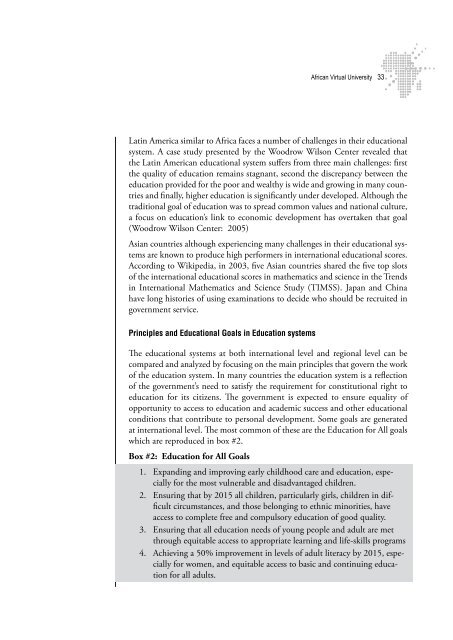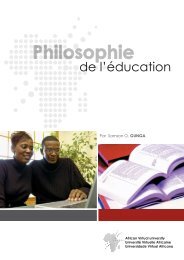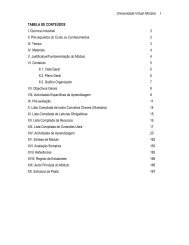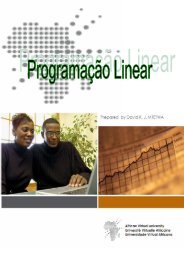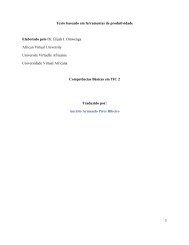Comparative Education.pdf - OER@AVU - African Virtual University
Comparative Education.pdf - OER@AVU - African Virtual University
Comparative Education.pdf - OER@AVU - African Virtual University
You also want an ePaper? Increase the reach of your titles
YUMPU automatically turns print PDFs into web optimized ePapers that Google loves.
<strong>African</strong> <strong>Virtual</strong> <strong>University</strong><br />
Latin America similar to Africa faces a number of challenges in their educational<br />
system. A case study presented by the Woodrow Wilson Center revealed that<br />
the Latin American educational system suffers from three main challenges: first<br />
the quality of education remains stagnant, second the discrepancy between the<br />
education provided for the poor and wealthy is wide and growing in many countries<br />
and finally, higher education is significantly under developed. Although the<br />
traditional goal of education was to spread common values and national culture,<br />
a focus on education’s link to economic development has overtaken that goal<br />
(Woodrow Wilson Center: 2005)<br />
Asian countries although experiencing many challenges in their educational systems<br />
are known to produce high performers in international educational scores.<br />
According to Wikipedia, in 2003, five Asian countries shared the five top slots<br />
of the international educational scores in mathematics and science in the Trends<br />
in International Mathematics and Science Study (TIMSS). Japan and China<br />
have long histories of using examinations to decide who should be recruited in<br />
government service.<br />
Principles and <strong>Education</strong>al Goals in <strong>Education</strong> systems<br />
The educational systems at both international level and regional level can be<br />
compared and analyzed by focusing on the main principles that govern the work<br />
of the education system. In many countries the education system is a reflection<br />
of the government’s need to satisfy the requirement for constitutional right to<br />
education for its citizens. The government is expected to ensure equality of<br />
opportunity to access to education and academic success and other educational<br />
conditions that contribute to personal development. Some goals are generated<br />
at international level. The most common of these are the <strong>Education</strong> for All goals<br />
which are reproduced in box #2.<br />
Box #2: <strong>Education</strong> for All Goals<br />
1. Expanding and improving early childhood care and education, especially<br />
for the most vulnerable and disadvantaged children.<br />
2. Ensuring that by 2015 all children, particularly girls, children in difficult<br />
circumstances, and those belonging to ethnic minorities, have<br />
access to complete free and compulsory education of good quality.<br />
3. Ensuring that all education needs of young people and adult are met<br />
through equitable access to appropriate learning and life-skills programs<br />
4. Achieving a 50% improvement in levels of adult literacy by 2015, especially<br />
for women, and equitable access to basic and continuing education<br />
for all adults.


